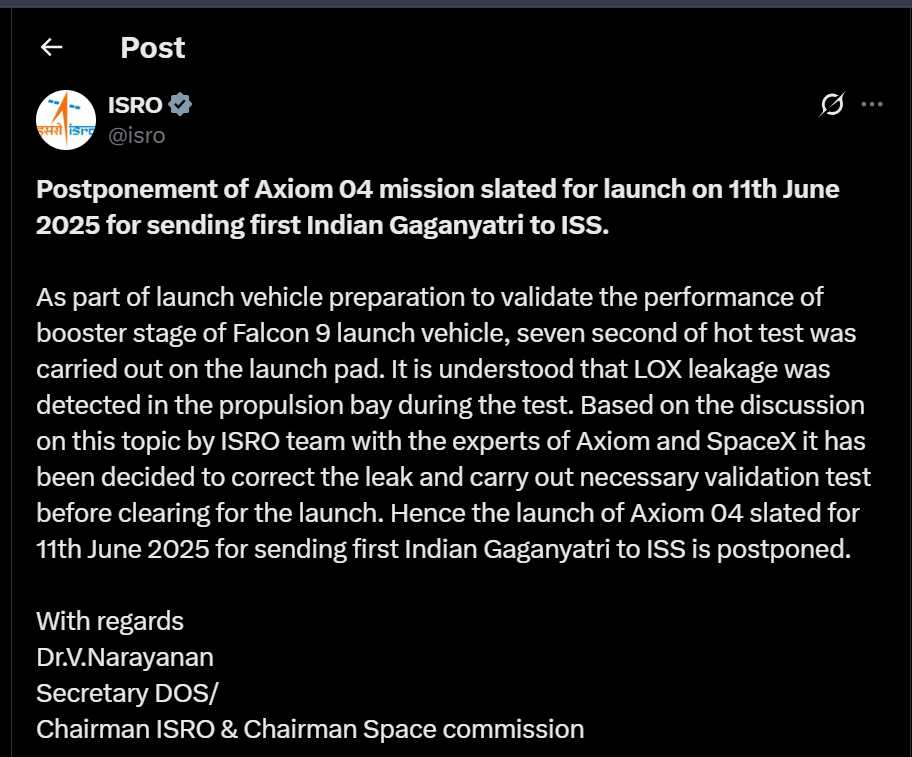What is Gaganyaan Mission: India is preparing for its first human spaceflight mission, Gaganyaan, set to launch in 2025. The mission will carry four astronauts, all experienced Indian Air Force (IAF) pilots, trained for this historic journey. One of them is Group Captain Shubhanshu Shukla.
Born on October 10, 1985, in Lucknow, Uttar Pradesh, Shukla is a skilled fighter pilot with over 2,000 hours of flight experience.
He joined the IAF in 2006 and became a test pilot, mastering various aircraft like the Su-30 MKI, MiG-21, and Jaguar. In 2019, he was selected for astronaut training and underwent rigorous preparation at Russia’s Yuri Gagarin Cosmonaut Training Center.
Standing down from tomorrow’s Falcon 9 launch of Ax-4 to the @Space_Station to allow additional time for SpaceX teams to repair the LOx leak identified during post static fire booster inspections. Once complete – and pending Range availability – we will share a new launch date pic.twitter.com/FwRc8k2Bc0
— SpaceX (@SpaceX) June 11, 2025
Apart from Gaganyaan, Shukla was chosen in 2024 to pilot Axiom Mission 4 (Ax-4) to the International Space Station (ISS). This will make him the first Indian astronaut to visit the ISS, marking a major milestone in India’s space journey. However, due to some technical issues with SpaceX's Falcon 9, the mission was postponed from June 10, 2025, to some other date.

Who is Shubhanshu Shukla? Know About His Age, Education, And Career
Shubhanshu Shukla is a distinguished Indian Air Force officer and astronaut, known for his remarkable achievements in aviation and space exploration. Here's an overview of his life, education, and career:
Early Life and Education
- Birth: Shubhanshu Shukla was born on October 10, 1985, in Lucknow, Uttar Pradesh, India.
- Schooling: He attended City Montessori School, Lucknow, where he demonstrated academic excellence and a keen interest in technology and aviation.
- Higher Education: Shukla graduated from the National Defence Academy (NDA), Pune, earning a Bachelor of Technology (B.Tech.) degree. He later pursued a Master of Technology at the Indian Institute of Science (IISc), Bangalore.
Career
- Indian Air Force Career: Commissioned into the IAF's fighter wing in June 2006, Shukla has accumulated over 2,000 hours of flying experience across various aircraft, including the Su-30 MKI, MiG-21, MiG-29, Jaguar, Hawk, Dornier, and An-32.
- Rank: He was promoted to the rank of Group Captain in March 2024.
- Astronaut Career: In 2019, Shukla was selected as one of the astronauts for India's Gaganyaan mission. He underwent rigorous training at the Yuri Gagarin Cosmonaut Training Centre in Russia.
- Axiom Mission 4: In 2024, he was chosen as the pilot for Axiom Mission 4, a joint mission with Axiom Space, NASA, and SpaceX, making him the first Indian astronaut to visit the International Space Station.
Achievements
- First Indian to Visit ISS: Shukla is set to become the first Indian astronaut to travel to the International Space Station as part of Axiom Mission 4.
- Gaganyaan Mission: He is also an astronaut-designate for India's maiden human spaceflight mission, Gaganyaan, scheduled for 2026.
What is the Gaganyaan Mission? Everything You Need to Know
.jpg)
The Gaganyaan Mission is India's ambitious human spaceflight program aimed at sending a crew of three astronauts to Low Earth Orbit (LEO) for a short duration. Here's an overview of the mission:
1. Mission Objectives
- Primary Goal: The mission's primary objective is to demonstrate India's indigenous capability to undertake human spaceflight missions to LEO.
- Long-term Vision: It aims to lay the foundation for a sustained Indian human space exploration programme, including future missions to the Moon and beyond.
2. Key Features
- Spacecraft Design: The Gaganyaan spacecraft consists of two main modules: the Crew Module (CM) and the Service Module (SM). The CM is designed to carry up to three astronauts, while the SM provides propulsion and power.
- Launch Vehicle: The spacecraft will be launched from the Satish Dhawan Space Centre using the Human-Rated Launch Vehicle (HRLV), a modified version of India's Launch Vehicle Mark III (LVM3).
- Mission Duration: Initially planned for a 5-7 day mission, the current plan is for a 3-day mission with a crew of three astronauts.
3. Significance
- Scientific Research: The mission will facilitate scientific experiments in microgravity, contributing to advancements in medicine, material science, and biology.
- International Collaboration: Success in this mission will open opportunities for international collaborations and strengthen India's position as a space-faring nation.
- Economic Impact: It is expected to stimulate economic growth through the development of space-related industries and job creation.
Gaganyaan Mission: Launch Date, Time, Astronauts List
.jpg)
The first crewed Gaganyaan mission, India's maiden human spaceflight program, is currently planned for late 2026 or early 2027, following a series of uncrewed test flights starting in 2025.
Here's a more detailed breakdown:
- Gaganyaan-1 (Uncrewed Test Flight 1): Tentatively planned for March 2025.
- Gaganyaan-2 (Uncrewed Test Flight 2): Planned for the first half of 2025.
- Gaganyaan-3 (Uncrewed Test Flight 3): Planned for the second half of 2025.
- Gaganyaan-4 (Crewed Flight): Expected to launch in late 2026 or early 2027.
- ISRO's Commitment: ISRO is prioritising safety and success, leading to the revised timeline and a cautious approach to human spaceflight.
- Mission Goals: The Gaganyaan mission aims to demonstrate India's human spaceflight capability by sending a crew of three to a 400-km low-Earth orbit for a three-day mission and ensuring their safe return.
- India's Space Ambitions: If successful, India will become the fourth country to conduct independent human spaceflight after the Soviet Union, the United States, and China.
- Future Plans: After the first crewed flight, ISRO intends to start a space station program, crewed lunar landings, and crewed interplanetary missions.
Astronauts List
The four astronauts selected for the Gaganyaan Mission are:
- Group Captain Prashanth Balakrishnan Nair
- Group Captain Ajit Krishnan
- Group Captain Angad Pratap
- Wing Commander Shubhanshu Shukla
These astronauts have undergone extensive training and are prepared for their roles in this historic mission, which aims to demonstrate India's human spaceflight capabilities by sending a crew into low Earth orbit for a three-day mission.
What Are the Main Objectives of the Gaganyaan Mission?
.jpg)
The main objectives of the Gaganyaan Mission are as follows:
- Demonstration of Human Spaceflight Capability: The primary goal is to demonstrate India's indigenous capability to send humans to Low Earth Orbit (LEO) and return them safely to Earth.
- Development of Critical Technologies: This includes developing a human-rated launch vehicle, life support systems, and crew escape systems essential for human spaceflight.
- Crew Training and Protocols: Establishing protocols for crew training, recovery, and rehabilitation is crucial for the success of future human space missions.
- Long-term Space Exploration: The mission lays the foundation for a sustained Indian human space exploration program, potentially leading to future missions to the Moon and beyond.
- Scientific Research and Advancements: The mission will facilitate scientific experiments in microgravity, contributing to advancements in fields like medicine, materials science, and biology.
How Will the Gaganyaan Mission Benefit India's Space Program?
The Gaganyaan Mission is poised to significantly benefit India's space program in several ways:
1. Technological Advancements
- Human Spaceflight Capability: The mission will demonstrate India's indigenous capability to undertake human spaceflight missions, placing it among the elite group of nations with this capability.
- Development of Critical Technologies: It involves developing a human-rated launch vehicle, life support systems, and crew escape systems, which are essential for future sustained human spaceflight activities.
2. Economic and Industrial Growth
- Boost to Industries: The mission is expected to source nearly 60% of its equipment from the Indian private sector, providing large opportunities for domestic industries and enhancing industrial capabilities.
- Employment Opportunities: It is anticipated to create around 15,000 new employment opportunities, contributing to economic growth through human resource development.
3. Scientific Research and Collaboration
- Research Opportunities: The mission will facilitate scientific experiments in microgravity, contributing to advancements in fields like materials processing, astrobiology, and planetary chemistry.
- International Collaboration: Success in this mission will strengthen international partnerships and enhance India's role in global space exploration.
4. Inspiration and Education
- Inspiration to Youth: The mission is expected to inspire a large number of young students to pursue careers in science and technology, contributing to national development.
5. Prestige and Diplomatic Influence
- Global Prestige: The mission will enhance India's global standing and diplomatic influence, positioning it as a key player in the space industry.
